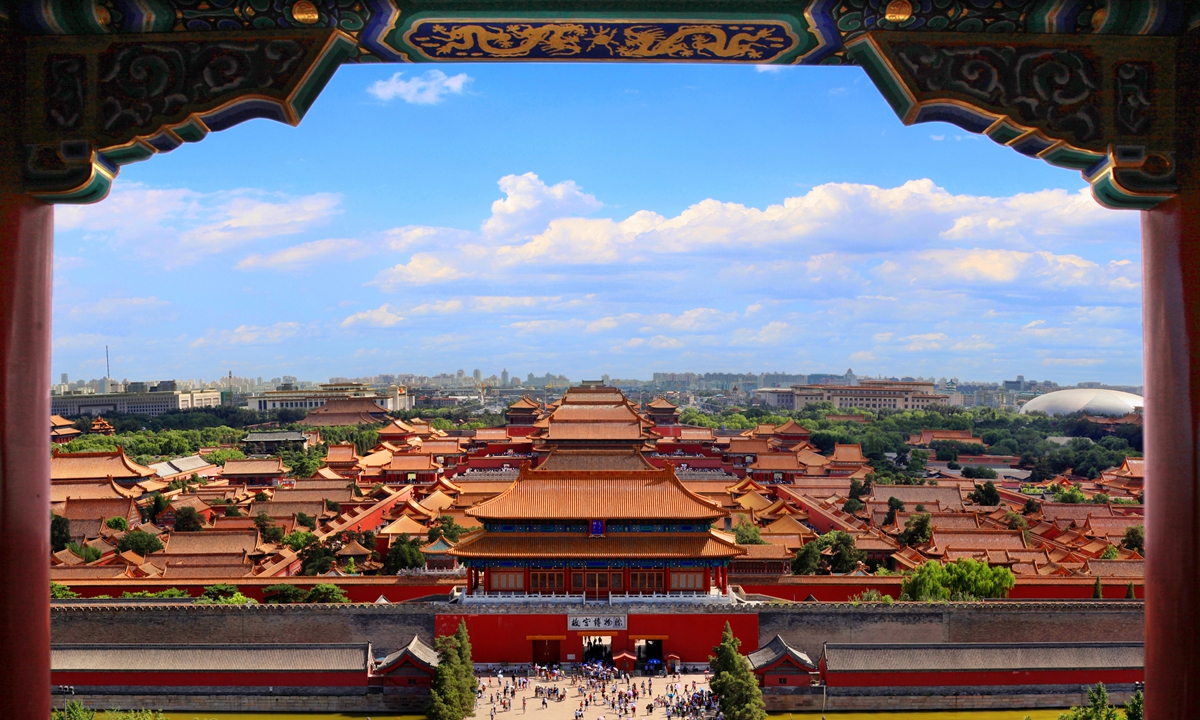
Blue sky in Beijing Photo:IC
The annual average concentration of PM2.5 in Beijing hit a record low in 2022, reaching the second-level national standard for the second year in a row, a result of the continuous effort of the city in improving air quality over the past decade, the city's ecology and environment authority said on Wednesday.
The city's annual atmospheric PM2.5 concentration fell to 30 micrograms per cubic meter in 2022, reaching the second-level national standard, a record low over the past decade and a further improvement from 33 micrograms per cubic meter in 2021, the Beijing Municipal Ecology and Environment Bureau announced at a press conference on Wednesday.
In 2022, Beijing saw the annual atmospheric PM2.5 concentration in all its districts reach the second-level national standard for the first time, ranging from 26 to 33 micrograms per cubic meter. The city has made efforts over the past few years with the citywide annual average concentration of PM2.5 reaching the second-level national standard in 2021 for the first time.
Also, the concentration of PM10, nitrogen dioxide and sulfur dioxide have remained in an overall downward trend and reached 54, 23 and 3 micrograms per cubic meter in 2022, maintaining at the expected second-level national standards, contributing to a steady improvement of the city's air quality, Liu Baoxian, director of the Beijing Municipal Ecological and Environmental Monitoring Center, said at the Wednesday briefing.
Compared with 2021, the annual average concentrations of PM2.5 fell by 9.1 percent, PM10 by 1.8 percent and NO2 by 11.5 percent year-on-year in 2022.
The annual average concentration of sulfur dioxide continued to maintain an extremely low single-digit concentration level in 2022.
The number of days with excellent and good air quality was 286 in Beijing in 2022, the same as in 2021. The days of excellent or good air quality accounted for nearly 80 percent of the entire year.
Among them, the number of days with excellent air quality reached 138, 24 days more than in 2021.
During the Beijing 2022 Winter Olympic Games, the average PM2.5 concentration in Beijing was 23 micrograms per cubic meter, and the air quality was good every day, fulfilling the pre-competition promise. The average PM2.5 concentration remained in single digits during the opening and closing ceremonies.
"Beijing Blue" has become the norm as the number of days with excellent air quality increased to 138 in 2022 from 41 days in 2013.
The number of heavy pollution days, and the frequency and the duration of heavy pollution decreased significantly over the past decade. The year-round number of days with heavy pollution decreased from 58 in 2013 to three in 2022, a cumulative decrease of 94.8 percent. Heavy pollution days related to PM2.5 were basically eliminated in spring and summer.
Beijing has made great efforts in various fields to reduce pollution and improve overall air quality.
For example, in 2022, the city worked out and implemented policies to encourage automobile upgrading and consumption, and encouraged residents to replace their vehicles with new-energy ones. A cumulative 580,000 new-energy vehicles were promoted in 2022, Li Xiang, director of the atmospheric environment department of the Beijing Municipal Ecology and Environment Bureau, said during the Wednesday briefing.
Other measures included reducing pollution and carbon emissions in the energy sector and strengthening the control of dust at construction sites, according to Li.
Global Times




